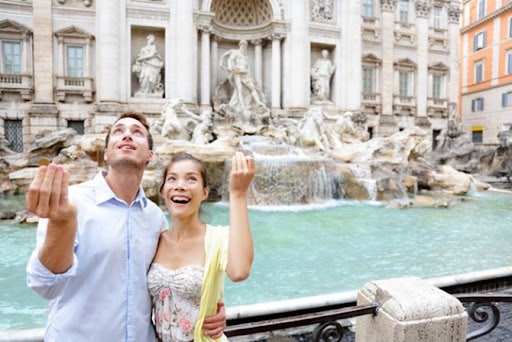Who started the tradition of throwing the coin in the Trevi Fountain?
You will surely have seen some tourists throw a coin into the Trevi Fountain. Legend has it that if you throw a coin with your back to the pool and then turn around and see it before disappearing into the water, your return to Rome is guaranteed. Who was the first to do it?

The Trevi Fountain is one of the capital’s most famous monuments abroad. The fountain, built in front of Palazzo Poli, occupies the whole square that was built precisely for its construction when several buildings were demolished. It is one of the most significant examples of the Baroque style in Rome, but it is above all one of the places where tourists most love to be photographed. Especially in the act of the famous toss of the coin. The rite is used to wish a return to the city. If one day you go to Rome, when you are with your back to the fountain, throw a coin backwards, and do not turn around until it has fallen.
The Trevi Fountain is the largest and one of the most famous fountains in Rome.

Tradition has it that if you throw a coin with your back to the tub and then turn quickly to meet the moment when the coin enters the water, you will certainly return to Rome.
Throwing coins into fountains or wells to propitiate luck is a gesture with ancient origins and is probably attributable to the belief that water was inhabited by divinities.

In particular, the Celtic and Germanic populations used to place wooden statues near the wells and the Germans themselves threw the weapons of their defeated enemies into streams or ponds as an offering to the deities who thought they lived there.
Among the most famous gods connected to water was Mimir, famous in Nordic mythology for his wisdom and keeper of a magical source.
Making an offering to the deities was therefore a way to guarantee one’s luck and the fulfillment of the desire expressed, but it also had hygienic functions. The coins were in fact mostly composed of copper or silver, which in contact with water produced a chemical reaction that prevented it from becoming sour.

Today this custom is often a business, which in the most famous fountains in the world increases a lot in the periods of greater tourist turnout. The money raised was usually destined for charitable works, now for other works, always linked to assistance or maintenance of other works.
Carrying out this act with your eyes closed, turning your back towards Palazzo Poli, would favor a future return to the city. The origins of the tradition could derive from the ancient custom of throwing oboles or small gifts into sacred sources to propitiate the local divinity, as for wishing wells. According to some sources, the introduction of the coin toss in the Trevi fountain is attributed to the great German archaeologist Wolfgang Helbig who stayed in Rome between the late nineteenth and early twentieth centuries.

The scholar was in pain when he left Rome after a long stay. He thus decided to throw an old coin into the basin of the Trevi Fountain as a good omen to return soon to the Eternal City.
